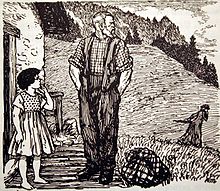I Gave My Son the Books I Loved. He Chose ‘Heidi’ Instead.
What a 19th-century Swiss novel, and a young fan’s pilgrimage to the Alps, taught a Times editor about fatherhood.
7 min read
Heidi (/ˈhaɪdi/; German: [ˈhaɪdi]) is a work of children's fiction published between 1880 and 1881 by Swiss author Johanna Spyri, originally published in two parts as Heidi: Her Years of Wandering and Learning[1] (German: Heidis Lehr- und Wanderjahre) and Heidi: How She Used What She Learned[2] (German: Heidi kann brauchen, was es gelernt hat).[3] It is a novel about the events in the life of a 3-year-old girl in her paternal grandfather's care in the Swiss Alps. It was written as a book "for children and those who love children" (as quoted from its subtitle).
Heidi is one of the best-selling books ever written and is among the best-known works of Swiss literature.[4][5]
 The cover of an 1887 published edition | |
| Author | Johanna Spyri |
|---|---|
| Original title | Originally published in two parts- Part 1: Heidi: Her Years of Neverending Learning, Part 2 Heidi: How She Used What She Learned |
| Translator | Helen Bennett Dole |
| Language | German |
| Genre | Children's fiction |
Publication date | 1880 (1st volume) 1881 (2nd volume) |
| Publication place | Switzerland |
| Followed by | Heidi Grows Up |
| Text | Heidi at Wikisource |
Heidi (/ˈhaɪdi/; German: [ˈhaɪdi]) is a work of children's fiction published between 1880 and 1881 by Swiss author Johanna Spyri, originally published in two parts as Heidi: Her Years of Wandering and Learning[1] (German: Heidis Lehr- und Wanderjahre) and Heidi: How She Used What She Learned[2] (German: Heidi kann brauchen, was es gelernt hat).[3] It is a novel about the events in the life of a 3-year-old girl in her paternal grandfather's care in the Swiss Alps. It was written as a book "for children and those who love children" (as quoted from its subtitle).
Heidi is one of the best-selling books ever written and is among the best-known works of Swiss literature.[4][5]
Plot
[edit]
In the town of Domleschg, lived two brothers. The older wasted the family fortune on drinking and gambling, while the younger ran away to serve in the Kingdom of the Two Sicilies's Army in Naples. Upon his return with a son, Tobias, they go to Domleschg, Tobias is sent to Mels for an apprenticeship, then reuniting they move to Dörfli ('small village' in Swiss German) in the municipality of Maienfeld the villagers ostracize him and create rumors surrounding his life in Naples. The man becomes known as The Alm-Uncle, as he lives in seclusion on the mountain Alm. Two village girls, sisters Dete and Adelheid, befriend Tobias. When they grow, Dete takes a job in the town of Maienfeld, in the Grisons, as a hotel maid. Adelheid and Tobias marry and work as carpenters. They have a daughter, also named Adelheid but affectionately nicknamed Heidi. Soon after, Tobias is killed in a work accident and Adelheid dies of shock. The Alm-Uncle holds this against God and becomes bitter.
Heidi[6] is initially raised by her maternal grandmother and Dete in Maienfeld. Shortly after the grandmother's death, Dete is offered a good job as a maid in the big city, and takes 5-year-old Heidi to live with the Alm-Uncle as her paternal grandfather. He briefly resents Heidi's arrival, but the girl's evident intelligence and cheerful yet unaffected demeanour soon earn his genuine, if reserved, love.

沒有留言:
張貼留言
注意:只有此網誌的成員可以留言。